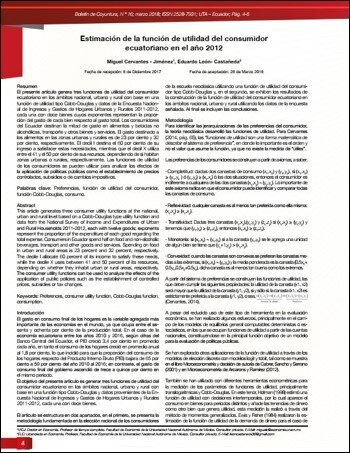Estimate of the utility function of the Ecuadorian consumer in 2012
Main Article Content
Abstract
This article generates three consumer utility functions at the national, urban and rural level based on a Cobb-Douglas type utility function and data from the National Survey of Income and Expenditures of Urban and Rural Households 2011-2012, each with twelve goods; exponents represent the proportion of the expenditure of each good regarding the total expense. Consumers in Ecuador spend half on food and non-alcoholic beverages, transport and other goods and services. Spending on food in urban and rural areas is 23 percent and 32 percent, respectively. The decile I allocate 60 percent of its income to satisfy these needs, while the decile X uses between 41 and 50 percent of its resources, depending on whether they inhabit urban or rural areas, respectively. The consumer utility functions can be used to analyze the effects of the application of public policies such as the establishment of controlled prices, subsidies or tax changes.
DOI: https://doi.org/10.31164/bcoyu.16.2018.658
URL: http://revistas.uta.edu.ec/erevista/index.php/bcoyu/article/view/658
Downloads
Article Details

This work is licensed under a Creative Commons Attribution-NonCommercial 4.0 International License.
![]()
The publications of the Boletín de Coyuntura are licensed under a Creative Commons Attribution-NonCommercial 4.0 International License (CC BY-NC 4.0). The Universidad Técnica de Ambato retains the copyright of the published works, and favors and allows the reuse of these, as long as: the authorship and original source of publication is cited, and they are not used for commercial or onerous purposes. The intellectual property of the published articles belongs to the authors.
References
Arcarons, J. & Ramírez, S. (2012). Microeconometría. Madrid: Delta publicaciones.
Cabrer, D., Sancho A. & Serrano G. (2001). Microeconometría y decisión. Madrid: Ediciones Pirámide.
Cervantes, M. (2014). Microeconomía. Teoría, Simuladores Computacionales y Retos. Ciudad de México: LAES.
Christensen, L., Lau, D. & Lawrence, J. (1975). Transcendental Logarithmic Utility Functions. The American Economic Review, Vol. 65, No. 3, 367-383.
Ewis, N. & Fisher, D. (1984). The Translog Utility Function and the Demand for Money in the United States. Journal of Money, Credit and Banking, Vol. 16, No. 1, 34-52.
Fortune, J. (1979). The Translog Utility Function, Quotas, Tariffs, and Consumers. The Translog Utility Function, Quotas, Tariffs, and Consumers, 735-743.
Holman, J. (1998). GMM Estimation of a Money in the Utility Function Model: The Implications of Functional Forms. Journal of Money, Credit and Banking, Vol. 30, No. 4, 679-698.
Instituto Nacional de Estadística y Censos. (2012). Encuesta Nacional de Ingresos y Gastos de los hogares urbanos y rurales 2011- 2012. Resumen metodológico y principales resultados. Ecuador: INEC.
Kim, Y. (1988). The Consumer Demand for Education. The Journal of Human Resources, Vol. 23, No. 2, 173-192.


